Certificate IV in Accounting and Bookkeeping FNS40217 Assignment
VerifiedAdded on 2023/01/20
|13
|3670
|46
Homework Assignment
AI Summary
This assignment solution for FNS40217 Certificate IV in Accounting and Bookkeeping covers various aspects of the accounting industry, including time management, prioritizing tasks, and essential resources like accounting software and receipts. It explores the significance of teamwork, providing effective feedback, and understanding intrinsic and extrinsic rewards in the workplace. The solution also addresses how technological advancements have influenced financial procedures, such as data security, automation, and paperless processes. Furthermore, it delves into payroll calculations, superannuation contributions, and conflict resolution within a team setting, emphasizing the importance of communication and consultation. The assignment provides practical examples and scenarios to illustrate these concepts, offering a comprehensive understanding of the subject matter.
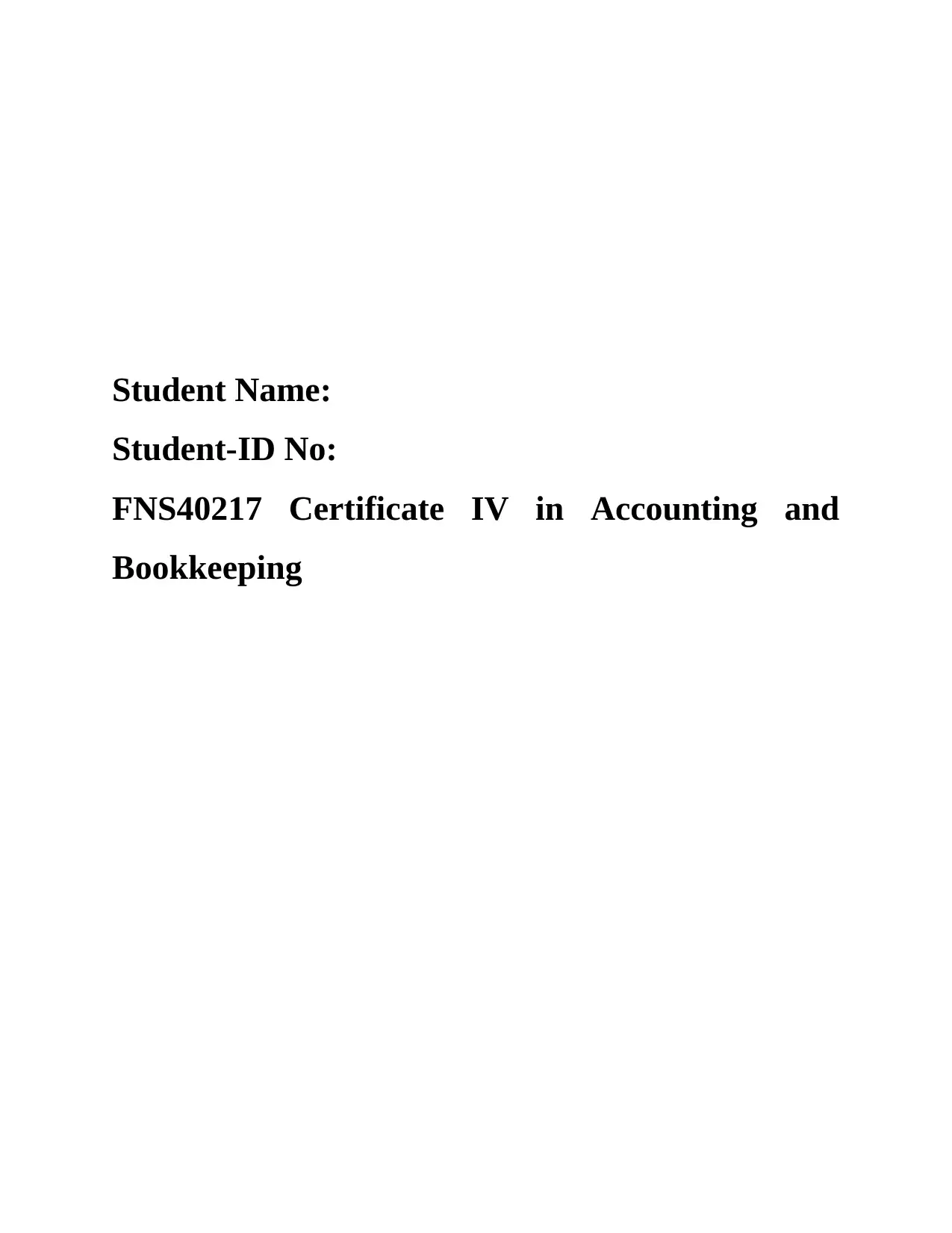
Student Name:
Student-ID No:
FNS40217 Certificate IV in Accounting and
Bookkeeping
Student-ID No:
FNS40217 Certificate IV in Accounting and
Bookkeeping
Paraphrase This Document
Need a fresh take? Get an instant paraphrase of this document with our AI Paraphraser
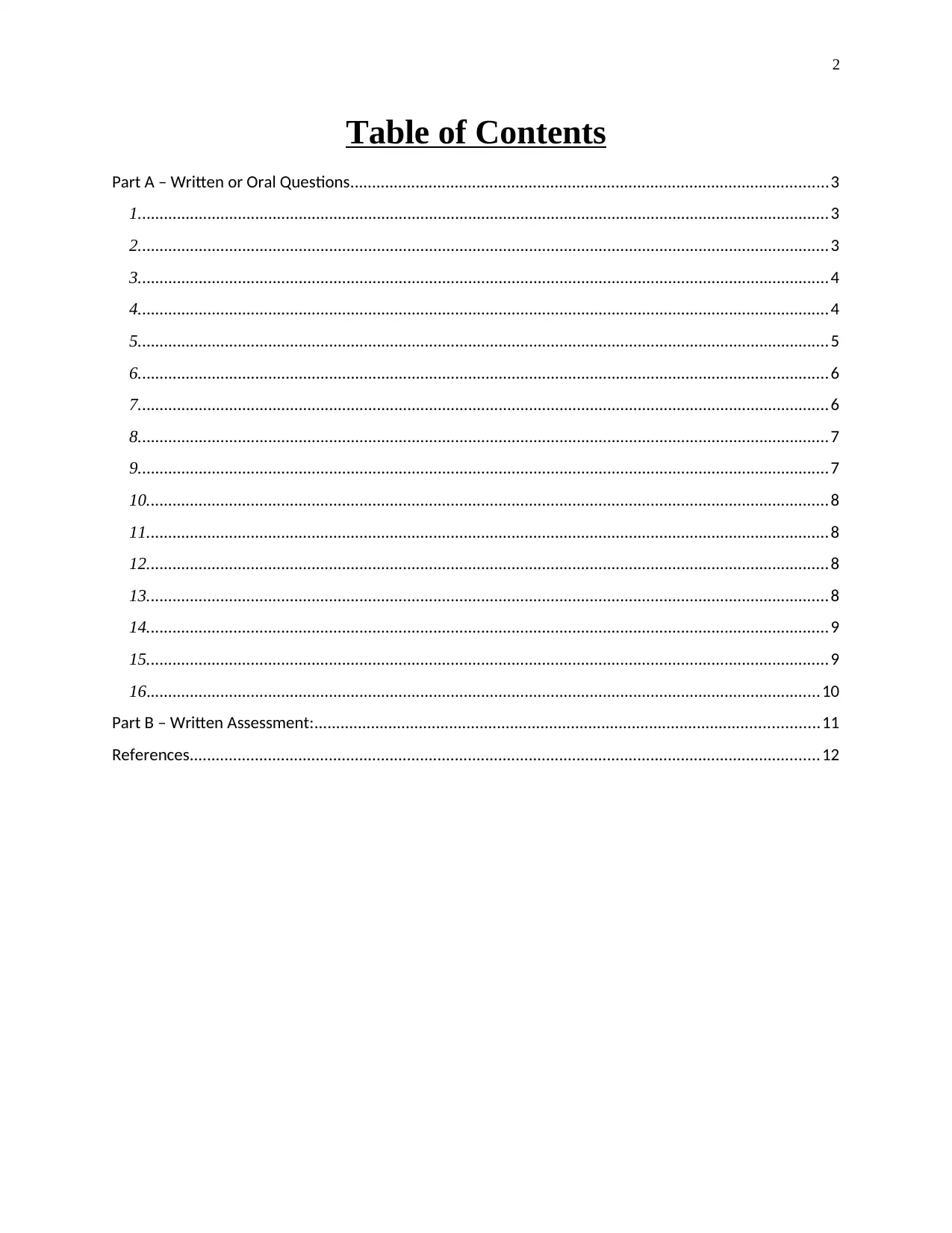
2
Table of Contents
Part A – Written or Oral Questions..............................................................................................................3
1...............................................................................................................................................................3
2...............................................................................................................................................................3
3...............................................................................................................................................................4
4...............................................................................................................................................................4
5...............................................................................................................................................................5
6...............................................................................................................................................................6
7...............................................................................................................................................................6
8...............................................................................................................................................................7
9...............................................................................................................................................................7
10.............................................................................................................................................................8
11.............................................................................................................................................................8
12.............................................................................................................................................................8
13.............................................................................................................................................................8
14.............................................................................................................................................................9
15.............................................................................................................................................................9
16...........................................................................................................................................................10
Part B – Written Assessment:....................................................................................................................11
References.................................................................................................................................................12
Table of Contents
Part A – Written or Oral Questions..............................................................................................................3
1...............................................................................................................................................................3
2...............................................................................................................................................................3
3...............................................................................................................................................................4
4...............................................................................................................................................................4
5...............................................................................................................................................................5
6...............................................................................................................................................................6
7...............................................................................................................................................................6
8...............................................................................................................................................................7
9...............................................................................................................................................................7
10.............................................................................................................................................................8
11.............................................................................................................................................................8
12.............................................................................................................................................................8
13.............................................................................................................................................................8
14.............................................................................................................................................................9
15.............................................................................................................................................................9
16...........................................................................................................................................................10
Part B – Written Assessment:....................................................................................................................11
References.................................................................................................................................................12
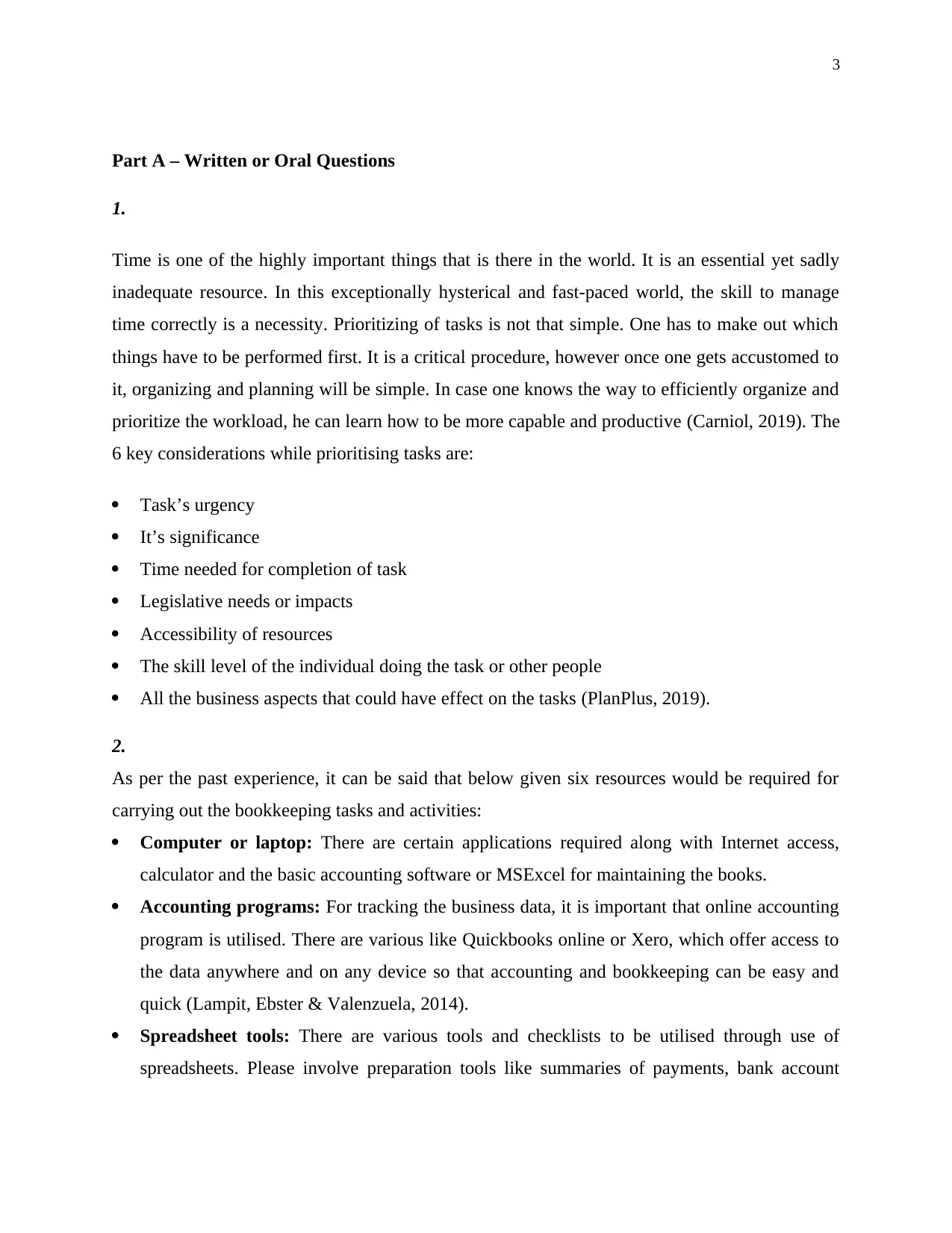
3
Part A – Written or Oral Questions
1.
Time is one of the highly important things that is there in the world. It is an essential yet sadly
inadequate resource. In this exceptionally hysterical and fast-paced world, the skill to manage
time correctly is a necessity. Prioritizing of tasks is not that simple. One has to make out which
things have to be performed first. It is a critical procedure, however once one gets accustomed to
it, organizing and planning will be simple. In case one knows the way to efficiently organize and
prioritize the workload, he can learn how to be more capable and productive (Carniol, 2019). The
6 key considerations while prioritising tasks are:
Task’s urgency
It’s significance
Time needed for completion of task
Legislative needs or impacts
Accessibility of resources
The skill level of the individual doing the task or other people
All the business aspects that could have effect on the tasks (PlanPlus, 2019).
2.
As per the past experience, it can be said that below given six resources would be required for
carrying out the bookkeeping tasks and activities:
Computer or laptop: There are certain applications required along with Internet access,
calculator and the basic accounting software or MSExcel for maintaining the books.
Accounting programs: For tracking the business data, it is important that online accounting
program is utilised. There are various like Quickbooks online or Xero, which offer access to
the data anywhere and on any device so that accounting and bookkeeping can be easy and
quick (Lampit, Ebster & Valenzuela, 2014).
Spreadsheet tools: There are various tools and checklists to be utilised through use of
spreadsheets. Please involve preparation tools like summaries of payments, bank account
Part A – Written or Oral Questions
1.
Time is one of the highly important things that is there in the world. It is an essential yet sadly
inadequate resource. In this exceptionally hysterical and fast-paced world, the skill to manage
time correctly is a necessity. Prioritizing of tasks is not that simple. One has to make out which
things have to be performed first. It is a critical procedure, however once one gets accustomed to
it, organizing and planning will be simple. In case one knows the way to efficiently organize and
prioritize the workload, he can learn how to be more capable and productive (Carniol, 2019). The
6 key considerations while prioritising tasks are:
Task’s urgency
It’s significance
Time needed for completion of task
Legislative needs or impacts
Accessibility of resources
The skill level of the individual doing the task or other people
All the business aspects that could have effect on the tasks (PlanPlus, 2019).
2.
As per the past experience, it can be said that below given six resources would be required for
carrying out the bookkeeping tasks and activities:
Computer or laptop: There are certain applications required along with Internet access,
calculator and the basic accounting software or MSExcel for maintaining the books.
Accounting programs: For tracking the business data, it is important that online accounting
program is utilised. There are various like Quickbooks online or Xero, which offer access to
the data anywhere and on any device so that accounting and bookkeeping can be easy and
quick (Lampit, Ebster & Valenzuela, 2014).
Spreadsheet tools: There are various tools and checklists to be utilised through use of
spreadsheets. Please involve preparation tools like summaries of payments, bank account
⊘ This is a preview!⊘
Do you want full access?
Subscribe today to unlock all pages.

Trusted by 1+ million students worldwide

4
statements, summary of end your tasks for workflow tools for managing everyday tasks and
keeping track of the financial details.
GST text book: Goods and Services Tax (GST) is a value added tax of 10% that is
implemented on the selling of goods and services within Australia. The Business Activity
Statement (BAS) is a report that organizations have to put forward to the Australian Tax
Office (ATO). It is utilised for reporting and paying their GST in a monthly or quarterly way
(GST distribution review, 2012). Each year there is a need of the GST handbook. Even
Google is a useful tool but textbook is also referred for confirming that the information that is
available on Google is correct. This is highly valuable tool for bookkeeping.
Electronic or paper receipts: These sports have to be kept as backup for the records along
with details of the expenditures and sales.
Taxation records and payroll information: The complete records of payroll and taxes have
to be maintained so that this can be added to the accounts or books.
3.
The working in teams enhances collaboration and gives an opportunity of brainstorming.
Therefore there are many ideas develop and there is enhancement in the productivity.
Two or more individuals are always better than single person to resolve issues, finish of the
tough tasks and enhance creativity (smallbiztrends.com, 2016).
Everybody is unique and processes unique skills, experiences and backgrounds so other
people in the team can be helpful in looking at things with different perspective.
Teamwork supports communication amongst the team members and therefore the
relationship among the workers becomes improved and with time the staff Learns to
communicate in a better way.
4.
Feedback has been an important part of performance improvement. The three features of
effective feedback are:
Instantaneous: the excellent feedback is one which is immediate and is given when all the
information is fresh in the mind. In case there has to be a lender waiting time for letting
anybody know how one things their performance food enhance, it can have less effect and
would make it tough for the individual to grasp exactly what needs to be changed. There is a
statements, summary of end your tasks for workflow tools for managing everyday tasks and
keeping track of the financial details.
GST text book: Goods and Services Tax (GST) is a value added tax of 10% that is
implemented on the selling of goods and services within Australia. The Business Activity
Statement (BAS) is a report that organizations have to put forward to the Australian Tax
Office (ATO). It is utilised for reporting and paying their GST in a monthly or quarterly way
(GST distribution review, 2012). Each year there is a need of the GST handbook. Even
Google is a useful tool but textbook is also referred for confirming that the information that is
available on Google is correct. This is highly valuable tool for bookkeeping.
Electronic or paper receipts: These sports have to be kept as backup for the records along
with details of the expenditures and sales.
Taxation records and payroll information: The complete records of payroll and taxes have
to be maintained so that this can be added to the accounts or books.
3.
The working in teams enhances collaboration and gives an opportunity of brainstorming.
Therefore there are many ideas develop and there is enhancement in the productivity.
Two or more individuals are always better than single person to resolve issues, finish of the
tough tasks and enhance creativity (smallbiztrends.com, 2016).
Everybody is unique and processes unique skills, experiences and backgrounds so other
people in the team can be helpful in looking at things with different perspective.
Teamwork supports communication amongst the team members and therefore the
relationship among the workers becomes improved and with time the staff Learns to
communicate in a better way.
4.
Feedback has been an important part of performance improvement. The three features of
effective feedback are:
Instantaneous: the excellent feedback is one which is immediate and is given when all the
information is fresh in the mind. In case there has to be a lender waiting time for letting
anybody know how one things their performance food enhance, it can have less effect and
would make it tough for the individual to grasp exactly what needs to be changed. There is a
Paraphrase This Document
Need a fresh take? Get an instant paraphrase of this document with our AI Paraphraser
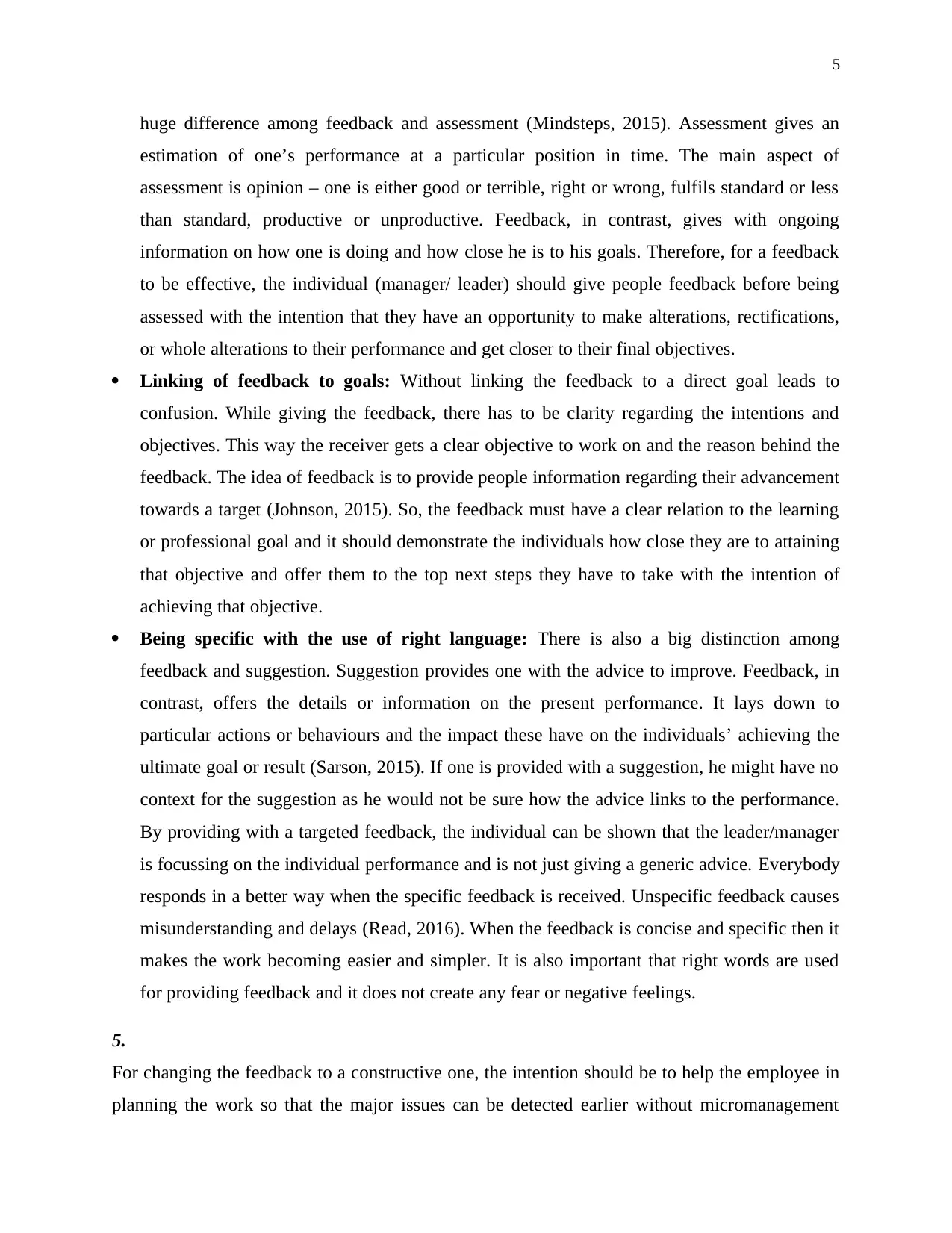
5
huge difference among feedback and assessment (Mindsteps, 2015). Assessment gives an
estimation of one’s performance at a particular position in time. The main aspect of
assessment is opinion – one is either good or terrible, right or wrong, fulfils standard or less
than standard, productive or unproductive. Feedback, in contrast, gives with ongoing
information on how one is doing and how close he is to his goals. Therefore, for a feedback
to be effective, the individual (manager/ leader) should give people feedback before being
assessed with the intention that they have an opportunity to make alterations, rectifications,
or whole alterations to their performance and get closer to their final objectives.
Linking of feedback to goals: Without linking the feedback to a direct goal leads to
confusion. While giving the feedback, there has to be clarity regarding the intentions and
objectives. This way the receiver gets a clear objective to work on and the reason behind the
feedback. The idea of feedback is to provide people information regarding their advancement
towards a target (Johnson, 2015). So, the feedback must have a clear relation to the learning
or professional goal and it should demonstrate the individuals how close they are to attaining
that objective and offer them to the top next steps they have to take with the intention of
achieving that objective.
Being specific with the use of right language: There is also a big distinction among
feedback and suggestion. Suggestion provides one with the advice to improve. Feedback, in
contrast, offers the details or information on the present performance. It lays down to
particular actions or behaviours and the impact these have on the individuals’ achieving the
ultimate goal or result (Sarson, 2015). If one is provided with a suggestion, he might have no
context for the suggestion as he would not be sure how the advice links to the performance.
By providing with a targeted feedback, the individual can be shown that the leader/manager
is focussing on the individual performance and is not just giving a generic advice. Everybody
responds in a better way when the specific feedback is received. Unspecific feedback causes
misunderstanding and delays (Read, 2016). When the feedback is concise and specific then it
makes the work becoming easier and simpler. It is also important that right words are used
for providing feedback and it does not create any fear or negative feelings.
5.
For changing the feedback to a constructive one, the intention should be to help the employee in
planning the work so that the major issues can be detected earlier without micromanagement
huge difference among feedback and assessment (Mindsteps, 2015). Assessment gives an
estimation of one’s performance at a particular position in time. The main aspect of
assessment is opinion – one is either good or terrible, right or wrong, fulfils standard or less
than standard, productive or unproductive. Feedback, in contrast, gives with ongoing
information on how one is doing and how close he is to his goals. Therefore, for a feedback
to be effective, the individual (manager/ leader) should give people feedback before being
assessed with the intention that they have an opportunity to make alterations, rectifications,
or whole alterations to their performance and get closer to their final objectives.
Linking of feedback to goals: Without linking the feedback to a direct goal leads to
confusion. While giving the feedback, there has to be clarity regarding the intentions and
objectives. This way the receiver gets a clear objective to work on and the reason behind the
feedback. The idea of feedback is to provide people information regarding their advancement
towards a target (Johnson, 2015). So, the feedback must have a clear relation to the learning
or professional goal and it should demonstrate the individuals how close they are to attaining
that objective and offer them to the top next steps they have to take with the intention of
achieving that objective.
Being specific with the use of right language: There is also a big distinction among
feedback and suggestion. Suggestion provides one with the advice to improve. Feedback, in
contrast, offers the details or information on the present performance. It lays down to
particular actions or behaviours and the impact these have on the individuals’ achieving the
ultimate goal or result (Sarson, 2015). If one is provided with a suggestion, he might have no
context for the suggestion as he would not be sure how the advice links to the performance.
By providing with a targeted feedback, the individual can be shown that the leader/manager
is focussing on the individual performance and is not just giving a generic advice. Everybody
responds in a better way when the specific feedback is received. Unspecific feedback causes
misunderstanding and delays (Read, 2016). When the feedback is concise and specific then it
makes the work becoming easier and simpler. It is also important that right words are used
for providing feedback and it does not create any fear or negative feelings.
5.
For changing the feedback to a constructive one, the intention should be to help the employee in
planning the work so that the major issues can be detected earlier without micromanagement
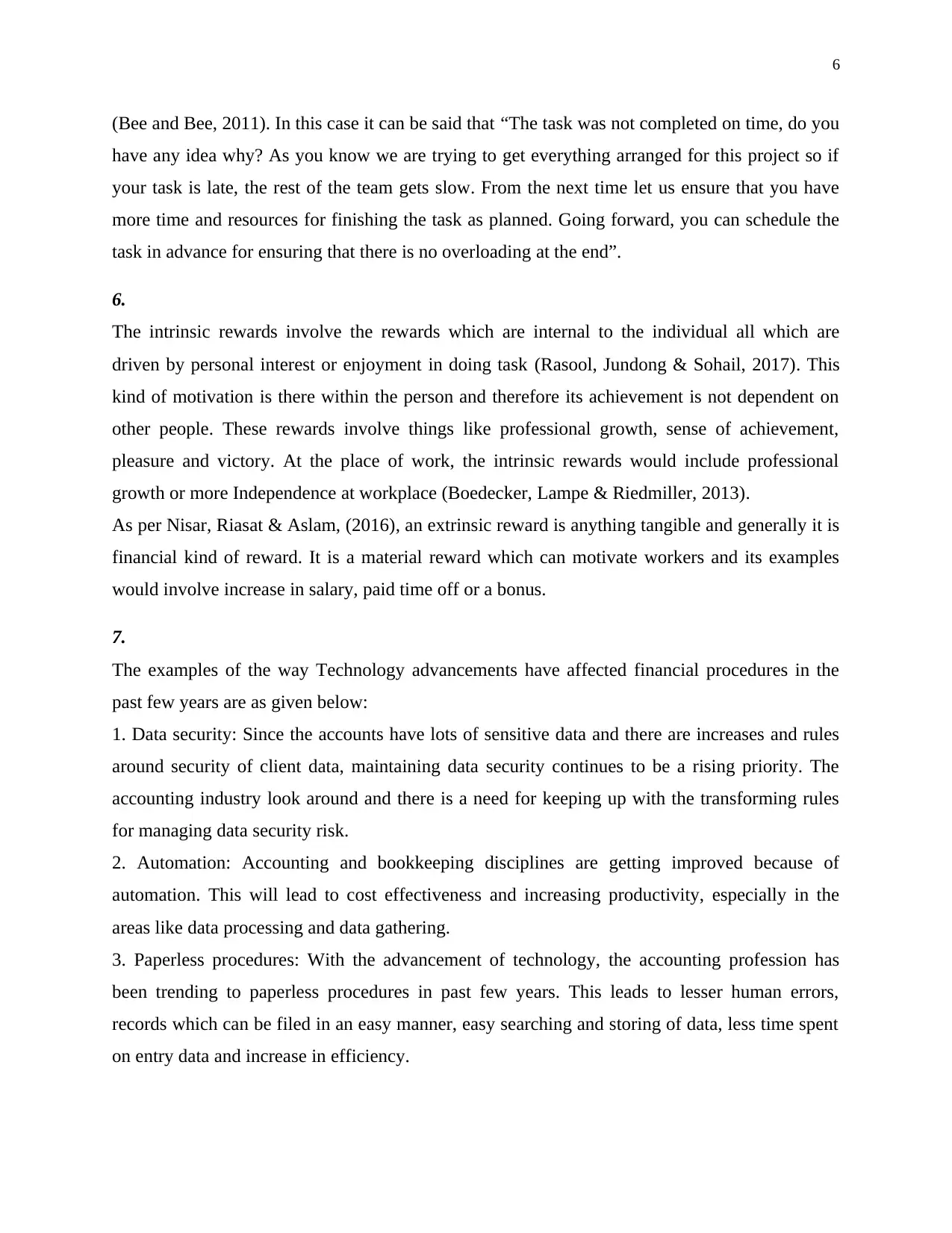
6
(Bee and Bee, 2011). In this case it can be said that “The task was not completed on time, do you
have any idea why? As you know we are trying to get everything arranged for this project so if
your task is late, the rest of the team gets slow. From the next time let us ensure that you have
more time and resources for finishing the task as planned. Going forward, you can schedule the
task in advance for ensuring that there is no overloading at the end”.
6.
The intrinsic rewards involve the rewards which are internal to the individual all which are
driven by personal interest or enjoyment in doing task (Rasool, Jundong & Sohail, 2017). This
kind of motivation is there within the person and therefore its achievement is not dependent on
other people. These rewards involve things like professional growth, sense of achievement,
pleasure and victory. At the place of work, the intrinsic rewards would include professional
growth or more Independence at workplace (Boedecker, Lampe & Riedmiller, 2013).
As per Nisar, Riasat & Aslam, (2016), an extrinsic reward is anything tangible and generally it is
financial kind of reward. It is a material reward which can motivate workers and its examples
would involve increase in salary, paid time off or a bonus.
7.
The examples of the way Technology advancements have affected financial procedures in the
past few years are as given below:
1. Data security: Since the accounts have lots of sensitive data and there are increases and rules
around security of client data, maintaining data security continues to be a rising priority. The
accounting industry look around and there is a need for keeping up with the transforming rules
for managing data security risk.
2. Automation: Accounting and bookkeeping disciplines are getting improved because of
automation. This will lead to cost effectiveness and increasing productivity, especially in the
areas like data processing and data gathering.
3. Paperless procedures: With the advancement of technology, the accounting profession has
been trending to paperless procedures in past few years. This leads to lesser human errors,
records which can be filed in an easy manner, easy searching and storing of data, less time spent
on entry data and increase in efficiency.
(Bee and Bee, 2011). In this case it can be said that “The task was not completed on time, do you
have any idea why? As you know we are trying to get everything arranged for this project so if
your task is late, the rest of the team gets slow. From the next time let us ensure that you have
more time and resources for finishing the task as planned. Going forward, you can schedule the
task in advance for ensuring that there is no overloading at the end”.
6.
The intrinsic rewards involve the rewards which are internal to the individual all which are
driven by personal interest or enjoyment in doing task (Rasool, Jundong & Sohail, 2017). This
kind of motivation is there within the person and therefore its achievement is not dependent on
other people. These rewards involve things like professional growth, sense of achievement,
pleasure and victory. At the place of work, the intrinsic rewards would include professional
growth or more Independence at workplace (Boedecker, Lampe & Riedmiller, 2013).
As per Nisar, Riasat & Aslam, (2016), an extrinsic reward is anything tangible and generally it is
financial kind of reward. It is a material reward which can motivate workers and its examples
would involve increase in salary, paid time off or a bonus.
7.
The examples of the way Technology advancements have affected financial procedures in the
past few years are as given below:
1. Data security: Since the accounts have lots of sensitive data and there are increases and rules
around security of client data, maintaining data security continues to be a rising priority. The
accounting industry look around and there is a need for keeping up with the transforming rules
for managing data security risk.
2. Automation: Accounting and bookkeeping disciplines are getting improved because of
automation. This will lead to cost effectiveness and increasing productivity, especially in the
areas like data processing and data gathering.
3. Paperless procedures: With the advancement of technology, the accounting profession has
been trending to paperless procedures in past few years. This leads to lesser human errors,
records which can be filed in an easy manner, easy searching and storing of data, less time spent
on entry data and increase in efficiency.
⊘ This is a preview!⊘
Do you want full access?
Subscribe today to unlock all pages.

Trusted by 1+ million students worldwide

7
4. More effective client transactions: the advancement has brought digitalization of data and
operations. Accountants and clients will be capable of accessing the real-time data remotely.
They can simultaneously see, edit and add comments to the statements.
5. Mobile accounting: the mobile applications customised for accounting functions which help in
sending invoices from reading receives and making expense claims along with various other
accounting jobs. All this can be done by few sites on the mobile screen and the data gets
seamlessly backed up on the cloud.
6. Highly diverse role for Accountants: With the advancement of technology, the accounting
software and application can be developed which provide Accountants with more time two
Accountants for various tasks find they do not have to carry out time consuming task and now
they can also perform value adding roles like data analysis interpretation, revision of financial
planning suggestions as well as business Consulting Services
8.
a. $1600 (Gross wages $1,200 + Annual leave $400 )
b. The super contribution payable is 9.5% * $2000 i.e. $190 per month
c. Eric is eligible to a tax deduction for contributions made for Fred to a conforming
superannuation fund. The contributions are only deductible but in the year wherein they are
paid. To obtain the maximum from the deductions available, Eric has to ensure that the
contributions are got by their employees’ superannuation funds prior to the 30th June.
9.
a. Whereas Martin’s decision might have been the cause of disagreement however the issue is
that the employee communication and consultation was not there in the business decisions. In
any case, the workers will be capable of performing at their best in case they are aware of the
duties, right, obligations and get opportunity to meet there views known to the managers on
the problems affecting them. Since nowadays the flat management structure is prevailing
therefore the workers should have complete understanding of what they have to do and also
why. In this case communication and consultation issues were there and the manager was not
able to consult team member leading to uh inconsistency of application or approach.
4. More effective client transactions: the advancement has brought digitalization of data and
operations. Accountants and clients will be capable of accessing the real-time data remotely.
They can simultaneously see, edit and add comments to the statements.
5. Mobile accounting: the mobile applications customised for accounting functions which help in
sending invoices from reading receives and making expense claims along with various other
accounting jobs. All this can be done by few sites on the mobile screen and the data gets
seamlessly backed up on the cloud.
6. Highly diverse role for Accountants: With the advancement of technology, the accounting
software and application can be developed which provide Accountants with more time two
Accountants for various tasks find they do not have to carry out time consuming task and now
they can also perform value adding roles like data analysis interpretation, revision of financial
planning suggestions as well as business Consulting Services
8.
a. $1600 (Gross wages $1,200 + Annual leave $400 )
b. The super contribution payable is 9.5% * $2000 i.e. $190 per month
c. Eric is eligible to a tax deduction for contributions made for Fred to a conforming
superannuation fund. The contributions are only deductible but in the year wherein they are
paid. To obtain the maximum from the deductions available, Eric has to ensure that the
contributions are got by their employees’ superannuation funds prior to the 30th June.
9.
a. Whereas Martin’s decision might have been the cause of disagreement however the issue is
that the employee communication and consultation was not there in the business decisions. In
any case, the workers will be capable of performing at their best in case they are aware of the
duties, right, obligations and get opportunity to meet there views known to the managers on
the problems affecting them. Since nowadays the flat management structure is prevailing
therefore the workers should have complete understanding of what they have to do and also
why. In this case communication and consultation issues were there and the manager was not
able to consult team member leading to uh inconsistency of application or approach.
Paraphrase This Document
Need a fresh take? Get an instant paraphrase of this document with our AI Paraphraser
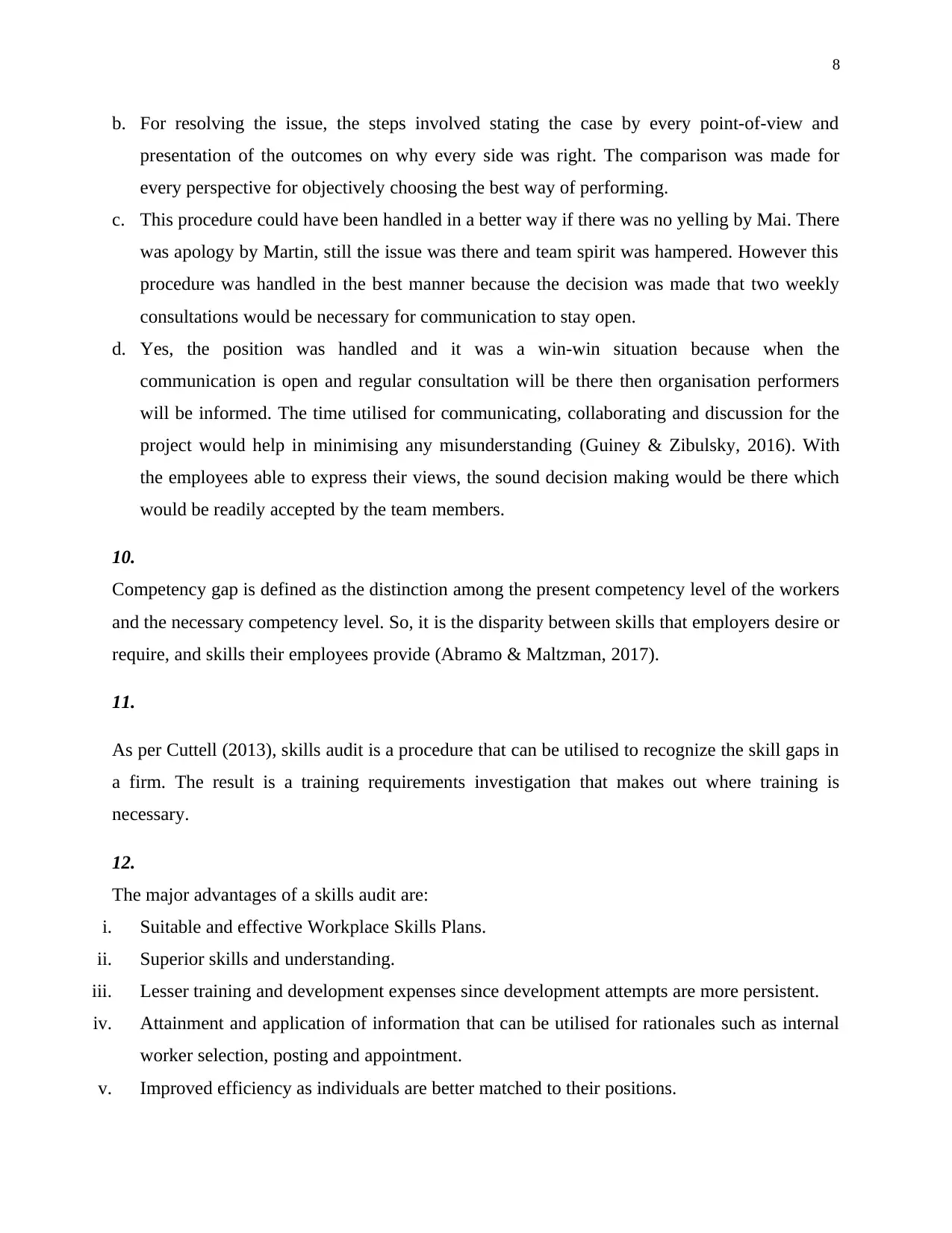
8
b. For resolving the issue, the steps involved stating the case by every point-of-view and
presentation of the outcomes on why every side was right. The comparison was made for
every perspective for objectively choosing the best way of performing.
c. This procedure could have been handled in a better way if there was no yelling by Mai. There
was apology by Martin, still the issue was there and team spirit was hampered. However this
procedure was handled in the best manner because the decision was made that two weekly
consultations would be necessary for communication to stay open.
d. Yes, the position was handled and it was a win-win situation because when the
communication is open and regular consultation will be there then organisation performers
will be informed. The time utilised for communicating, collaborating and discussion for the
project would help in minimising any misunderstanding (Guiney & Zibulsky, 2016). With
the employees able to express their views, the sound decision making would be there which
would be readily accepted by the team members.
10.
Competency gap is defined as the distinction among the present competency level of the workers
and the necessary competency level. So, it is the disparity between skills that employers desire or
require, and skills their employees provide (Abramo & Maltzman, 2017).
11.
As per Cuttell (2013), skills audit is a procedure that can be utilised to recognize the skill gaps in
a firm. The result is a training requirements investigation that makes out where training is
necessary.
12.
The major advantages of a skills audit are:
i. Suitable and effective Workplace Skills Plans.
ii. Superior skills and understanding.
iii. Lesser training and development expenses since development attempts are more persistent.
iv. Attainment and application of information that can be utilised for rationales such as internal
worker selection, posting and appointment.
v. Improved efficiency as individuals are better matched to their positions.
b. For resolving the issue, the steps involved stating the case by every point-of-view and
presentation of the outcomes on why every side was right. The comparison was made for
every perspective for objectively choosing the best way of performing.
c. This procedure could have been handled in a better way if there was no yelling by Mai. There
was apology by Martin, still the issue was there and team spirit was hampered. However this
procedure was handled in the best manner because the decision was made that two weekly
consultations would be necessary for communication to stay open.
d. Yes, the position was handled and it was a win-win situation because when the
communication is open and regular consultation will be there then organisation performers
will be informed. The time utilised for communicating, collaborating and discussion for the
project would help in minimising any misunderstanding (Guiney & Zibulsky, 2016). With
the employees able to express their views, the sound decision making would be there which
would be readily accepted by the team members.
10.
Competency gap is defined as the distinction among the present competency level of the workers
and the necessary competency level. So, it is the disparity between skills that employers desire or
require, and skills their employees provide (Abramo & Maltzman, 2017).
11.
As per Cuttell (2013), skills audit is a procedure that can be utilised to recognize the skill gaps in
a firm. The result is a training requirements investigation that makes out where training is
necessary.
12.
The major advantages of a skills audit are:
i. Suitable and effective Workplace Skills Plans.
ii. Superior skills and understanding.
iii. Lesser training and development expenses since development attempts are more persistent.
iv. Attainment and application of information that can be utilised for rationales such as internal
worker selection, posting and appointment.
v. Improved efficiency as individuals are better matched to their positions.
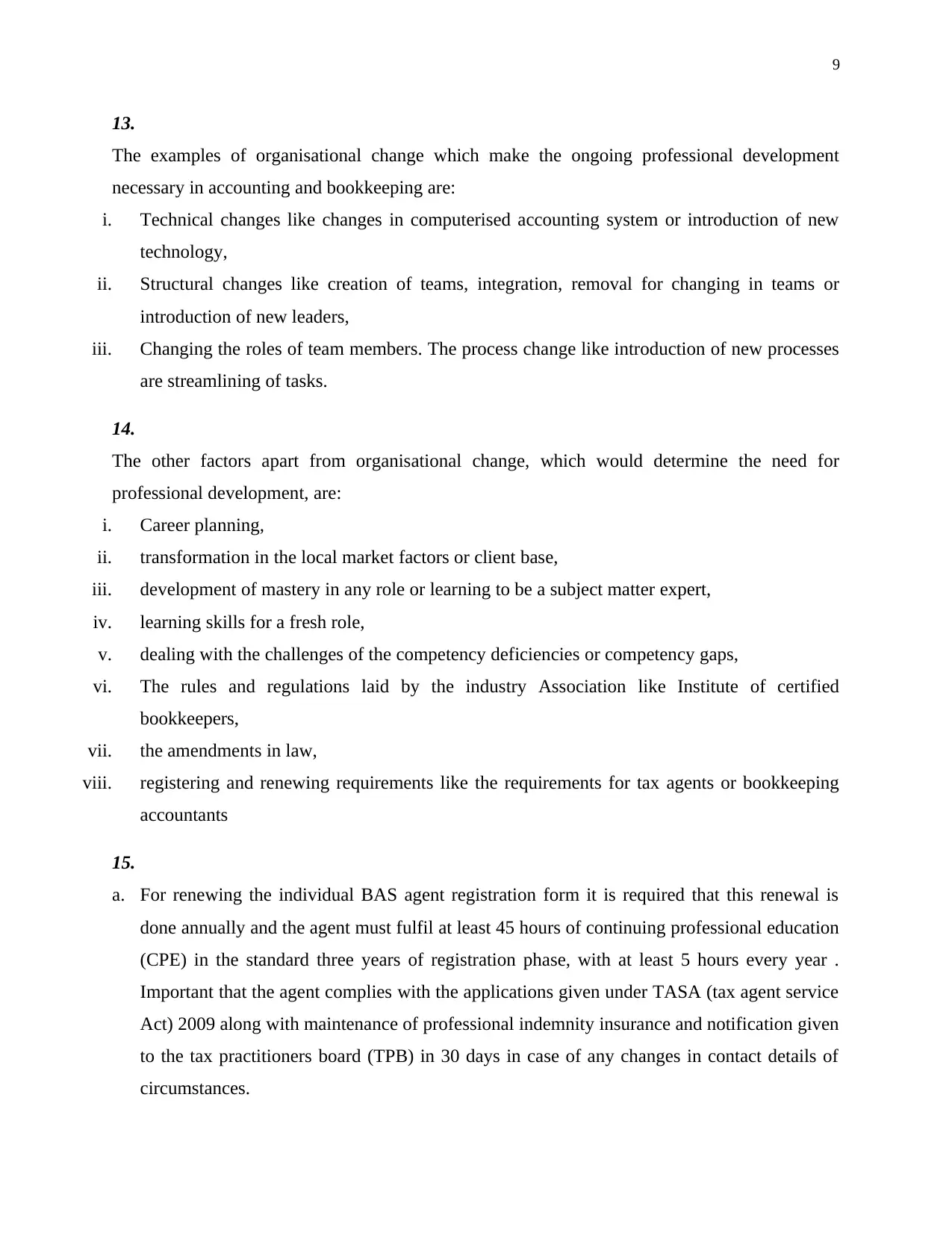
9
13.
The examples of organisational change which make the ongoing professional development
necessary in accounting and bookkeeping are:
i. Technical changes like changes in computerised accounting system or introduction of new
technology,
ii. Structural changes like creation of teams, integration, removal for changing in teams or
introduction of new leaders,
iii. Changing the roles of team members. The process change like introduction of new processes
are streamlining of tasks.
14.
The other factors apart from organisational change, which would determine the need for
professional development, are:
i. Career planning,
ii. transformation in the local market factors or client base,
iii. development of mastery in any role or learning to be a subject matter expert,
iv. learning skills for a fresh role,
v. dealing with the challenges of the competency deficiencies or competency gaps,
vi. The rules and regulations laid by the industry Association like Institute of certified
bookkeepers,
vii. the amendments in law,
viii. registering and renewing requirements like the requirements for tax agents or bookkeeping
accountants
15.
a. For renewing the individual BAS agent registration form it is required that this renewal is
done annually and the agent must fulfil at least 45 hours of continuing professional education
(CPE) in the standard three years of registration phase, with at least 5 hours every year .
Important that the agent complies with the applications given under TASA (tax agent service
Act) 2009 along with maintenance of professional indemnity insurance and notification given
to the tax practitioners board (TPB) in 30 days in case of any changes in contact details of
circumstances.
13.
The examples of organisational change which make the ongoing professional development
necessary in accounting and bookkeeping are:
i. Technical changes like changes in computerised accounting system or introduction of new
technology,
ii. Structural changes like creation of teams, integration, removal for changing in teams or
introduction of new leaders,
iii. Changing the roles of team members. The process change like introduction of new processes
are streamlining of tasks.
14.
The other factors apart from organisational change, which would determine the need for
professional development, are:
i. Career planning,
ii. transformation in the local market factors or client base,
iii. development of mastery in any role or learning to be a subject matter expert,
iv. learning skills for a fresh role,
v. dealing with the challenges of the competency deficiencies or competency gaps,
vi. The rules and regulations laid by the industry Association like Institute of certified
bookkeepers,
vii. the amendments in law,
viii. registering and renewing requirements like the requirements for tax agents or bookkeeping
accountants
15.
a. For renewing the individual BAS agent registration form it is required that this renewal is
done annually and the agent must fulfil at least 45 hours of continuing professional education
(CPE) in the standard three years of registration phase, with at least 5 hours every year .
Important that the agent complies with the applications given under TASA (tax agent service
Act) 2009 along with maintenance of professional indemnity insurance and notification given
to the tax practitioners board (TPB) in 30 days in case of any changes in contact details of
circumstances.
⊘ This is a preview!⊘
Do you want full access?
Subscribe today to unlock all pages.

Trusted by 1+ million students worldwide
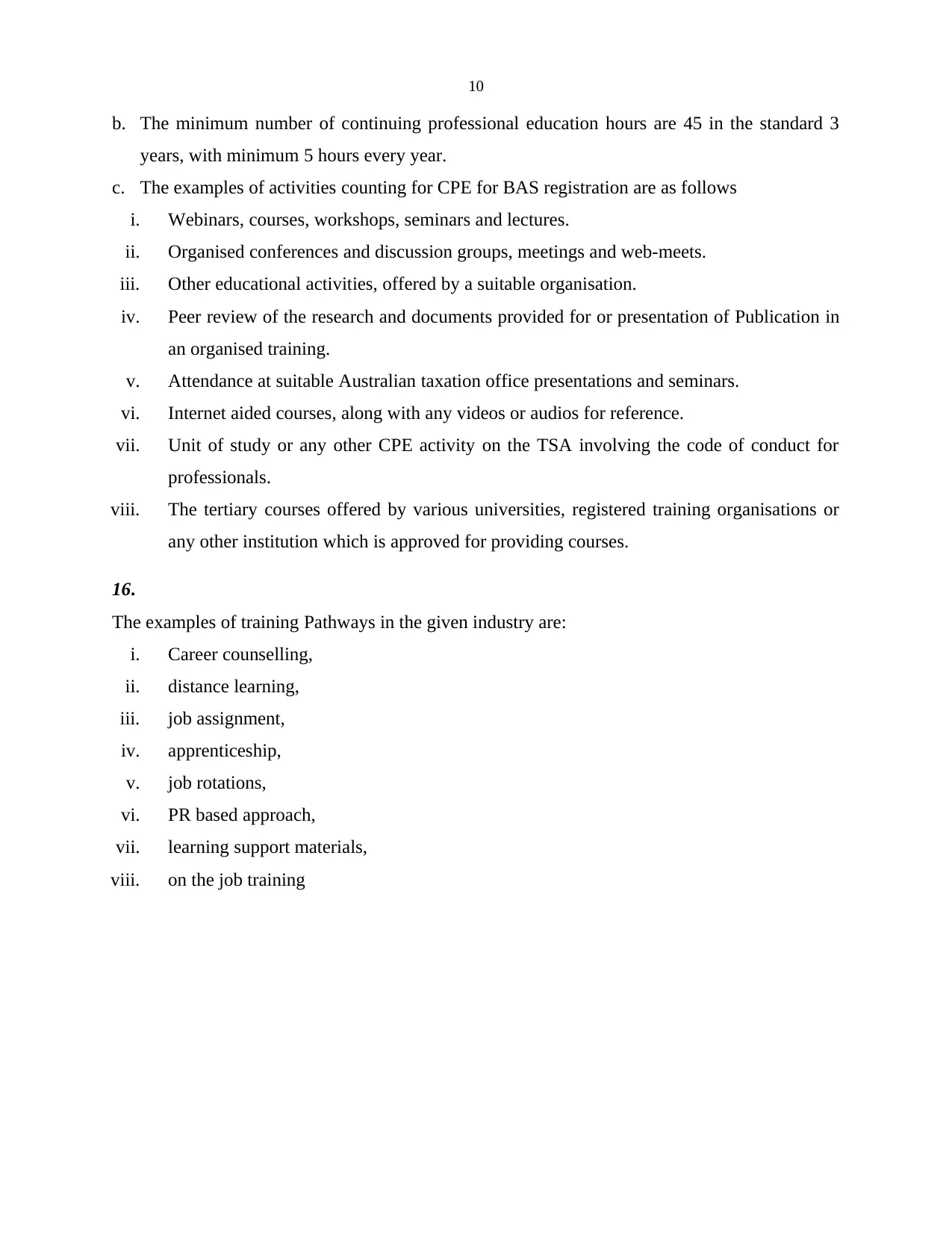
10
b. The minimum number of continuing professional education hours are 45 in the standard 3
years, with minimum 5 hours every year.
c. The examples of activities counting for CPE for BAS registration are as follows
i. Webinars, courses, workshops, seminars and lectures.
ii. Organised conferences and discussion groups, meetings and web-meets.
iii. Other educational activities, offered by a suitable organisation.
iv. Peer review of the research and documents provided for or presentation of Publication in
an organised training.
v. Attendance at suitable Australian taxation office presentations and seminars.
vi. Internet aided courses, along with any videos or audios for reference.
vii. Unit of study or any other CPE activity on the TSA involving the code of conduct for
professionals.
viii. The tertiary courses offered by various universities, registered training organisations or
any other institution which is approved for providing courses.
16.
The examples of training Pathways in the given industry are:
i. Career counselling,
ii. distance learning,
iii. job assignment,
iv. apprenticeship,
v. job rotations,
vi. PR based approach,
vii. learning support materials,
viii. on the job training
b. The minimum number of continuing professional education hours are 45 in the standard 3
years, with minimum 5 hours every year.
c. The examples of activities counting for CPE for BAS registration are as follows
i. Webinars, courses, workshops, seminars and lectures.
ii. Organised conferences and discussion groups, meetings and web-meets.
iii. Other educational activities, offered by a suitable organisation.
iv. Peer review of the research and documents provided for or presentation of Publication in
an organised training.
v. Attendance at suitable Australian taxation office presentations and seminars.
vi. Internet aided courses, along with any videos or audios for reference.
vii. Unit of study or any other CPE activity on the TSA involving the code of conduct for
professionals.
viii. The tertiary courses offered by various universities, registered training organisations or
any other institution which is approved for providing courses.
16.
The examples of training Pathways in the given industry are:
i. Career counselling,
ii. distance learning,
iii. job assignment,
iv. apprenticeship,
v. job rotations,
vi. PR based approach,
vii. learning support materials,
viii. on the job training
Paraphrase This Document
Need a fresh take? Get an instant paraphrase of this document with our AI Paraphraser
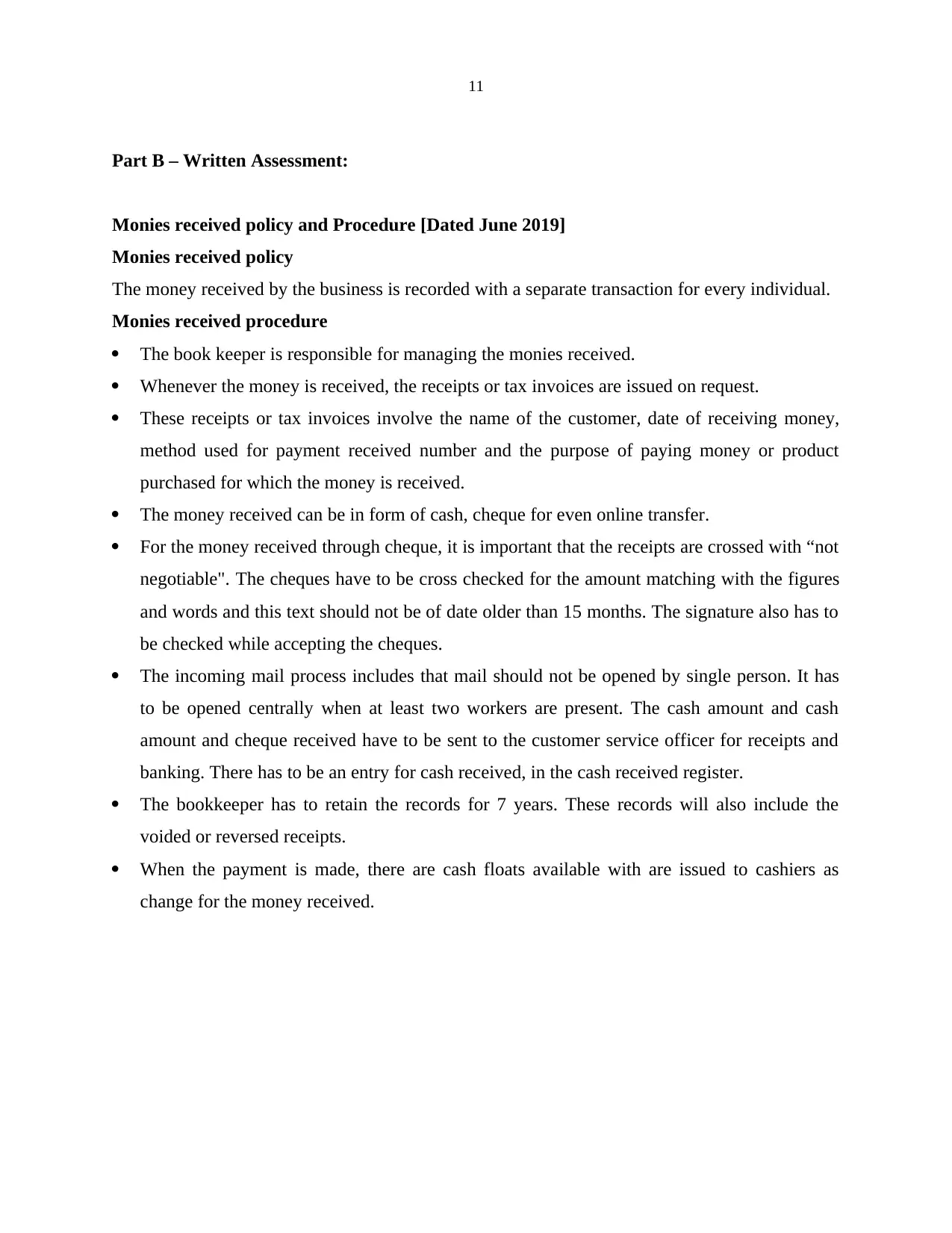
11
Part B – Written Assessment:
Monies received policy and Procedure [Dated June 2019]
Monies received policy
The money received by the business is recorded with a separate transaction for every individual.
Monies received procedure
The book keeper is responsible for managing the monies received.
Whenever the money is received, the receipts or tax invoices are issued on request.
These receipts or tax invoices involve the name of the customer, date of receiving money,
method used for payment received number and the purpose of paying money or product
purchased for which the money is received.
The money received can be in form of cash, cheque for even online transfer.
For the money received through cheque, it is important that the receipts are crossed with “not
negotiable". The cheques have to be cross checked for the amount matching with the figures
and words and this text should not be of date older than 15 months. The signature also has to
be checked while accepting the cheques.
The incoming mail process includes that mail should not be opened by single person. It has
to be opened centrally when at least two workers are present. The cash amount and cash
amount and cheque received have to be sent to the customer service officer for receipts and
banking. There has to be an entry for cash received, in the cash received register.
The bookkeeper has to retain the records for 7 years. These records will also include the
voided or reversed receipts.
When the payment is made, there are cash floats available with are issued to cashiers as
change for the money received.
Part B – Written Assessment:
Monies received policy and Procedure [Dated June 2019]
Monies received policy
The money received by the business is recorded with a separate transaction for every individual.
Monies received procedure
The book keeper is responsible for managing the monies received.
Whenever the money is received, the receipts or tax invoices are issued on request.
These receipts or tax invoices involve the name of the customer, date of receiving money,
method used for payment received number and the purpose of paying money or product
purchased for which the money is received.
The money received can be in form of cash, cheque for even online transfer.
For the money received through cheque, it is important that the receipts are crossed with “not
negotiable". The cheques have to be cross checked for the amount matching with the figures
and words and this text should not be of date older than 15 months. The signature also has to
be checked while accepting the cheques.
The incoming mail process includes that mail should not be opened by single person. It has
to be opened centrally when at least two workers are present. The cash amount and cash
amount and cheque received have to be sent to the customer service officer for receipts and
banking. There has to be an entry for cash received, in the cash received register.
The bookkeeper has to retain the records for 7 years. These records will also include the
voided or reversed receipts.
When the payment is made, there are cash floats available with are issued to cashiers as
change for the money received.
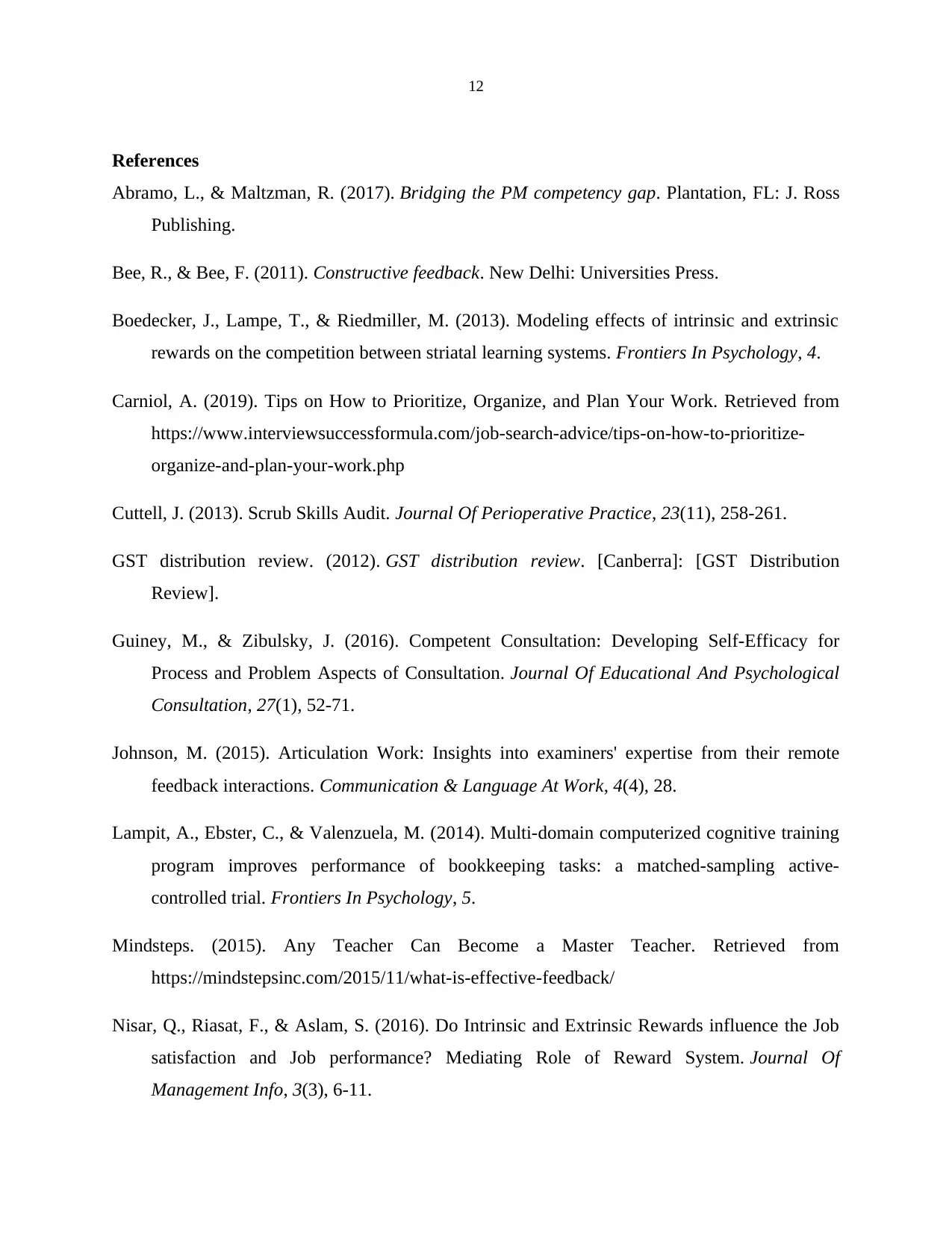
12
References
Abramo, L., & Maltzman, R. (2017). Bridging the PM competency gap. Plantation, FL: J. Ross
Publishing.
Bee, R., & Bee, F. (2011). Constructive feedback. New Delhi: Universities Press.
Boedecker, J., Lampe, T., & Riedmiller, M. (2013). Modeling effects of intrinsic and extrinsic
rewards on the competition between striatal learning systems. Frontiers In Psychology, 4.
Carniol, A. (2019). Tips on How to Prioritize, Organize, and Plan Your Work. Retrieved from
https://www.interviewsuccessformula.com/job-search-advice/tips-on-how-to-prioritize-
organize-and-plan-your-work.php
Cuttell, J. (2013). Scrub Skills Audit. Journal Of Perioperative Practice, 23(11), 258-261.
GST distribution review. (2012). GST distribution review. [Canberra]: [GST Distribution
Review].
Guiney, M., & Zibulsky, J. (2016). Competent Consultation: Developing Self-Efficacy for
Process and Problem Aspects of Consultation. Journal Of Educational And Psychological
Consultation, 27(1), 52-71.
Johnson, M. (2015). Articulation Work: Insights into examiners' expertise from their remote
feedback interactions. Communication & Language At Work, 4(4), 28.
Lampit, A., Ebster, C., & Valenzuela, M. (2014). Multi-domain computerized cognitive training
program improves performance of bookkeeping tasks: a matched-sampling active-
controlled trial. Frontiers In Psychology, 5.
Mindsteps. (2015). Any Teacher Can Become a Master Teacher. Retrieved from
https://mindstepsinc.com/2015/11/what-is-effective-feedback/
Nisar, Q., Riasat, F., & Aslam, S. (2016). Do Intrinsic and Extrinsic Rewards influence the Job
satisfaction and Job performance? Mediating Role of Reward System. Journal Of
Management Info, 3(3), 6-11.
References
Abramo, L., & Maltzman, R. (2017). Bridging the PM competency gap. Plantation, FL: J. Ross
Publishing.
Bee, R., & Bee, F. (2011). Constructive feedback. New Delhi: Universities Press.
Boedecker, J., Lampe, T., & Riedmiller, M. (2013). Modeling effects of intrinsic and extrinsic
rewards on the competition between striatal learning systems. Frontiers In Psychology, 4.
Carniol, A. (2019). Tips on How to Prioritize, Organize, and Plan Your Work. Retrieved from
https://www.interviewsuccessformula.com/job-search-advice/tips-on-how-to-prioritize-
organize-and-plan-your-work.php
Cuttell, J. (2013). Scrub Skills Audit. Journal Of Perioperative Practice, 23(11), 258-261.
GST distribution review. (2012). GST distribution review. [Canberra]: [GST Distribution
Review].
Guiney, M., & Zibulsky, J. (2016). Competent Consultation: Developing Self-Efficacy for
Process and Problem Aspects of Consultation. Journal Of Educational And Psychological
Consultation, 27(1), 52-71.
Johnson, M. (2015). Articulation Work: Insights into examiners' expertise from their remote
feedback interactions. Communication & Language At Work, 4(4), 28.
Lampit, A., Ebster, C., & Valenzuela, M. (2014). Multi-domain computerized cognitive training
program improves performance of bookkeeping tasks: a matched-sampling active-
controlled trial. Frontiers In Psychology, 5.
Mindsteps. (2015). Any Teacher Can Become a Master Teacher. Retrieved from
https://mindstepsinc.com/2015/11/what-is-effective-feedback/
Nisar, Q., Riasat, F., & Aslam, S. (2016). Do Intrinsic and Extrinsic Rewards influence the Job
satisfaction and Job performance? Mediating Role of Reward System. Journal Of
Management Info, 3(3), 6-11.
⊘ This is a preview!⊘
Do you want full access?
Subscribe today to unlock all pages.

Trusted by 1+ million students worldwide
1 out of 13
Related Documents
Your All-in-One AI-Powered Toolkit for Academic Success.
+13062052269
info@desklib.com
Available 24*7 on WhatsApp / Email
![[object Object]](/_next/static/media/star-bottom.7253800d.svg)
Unlock your academic potential
Copyright © 2020–2025 A2Z Services. All Rights Reserved. Developed and managed by ZUCOL.




